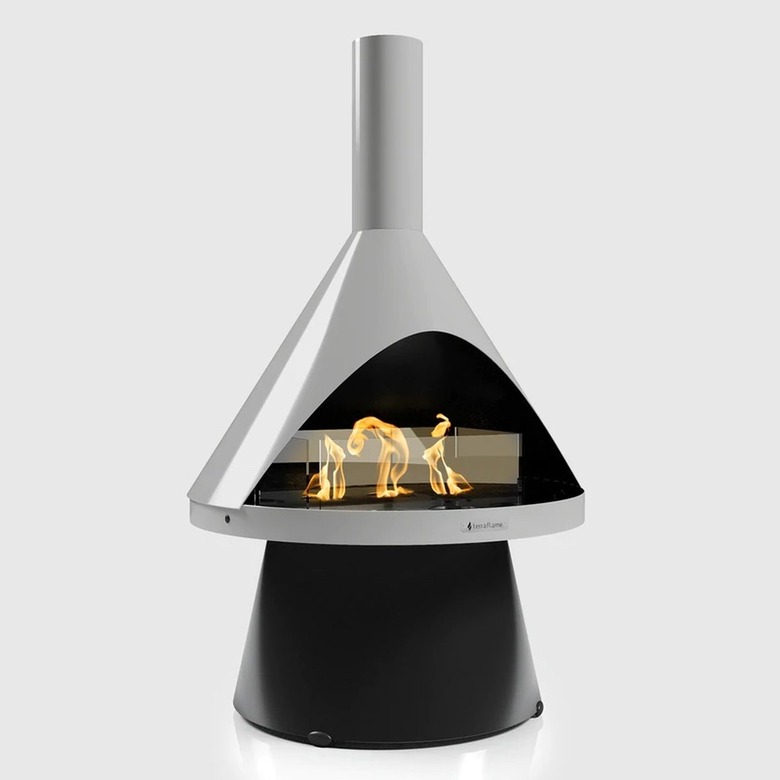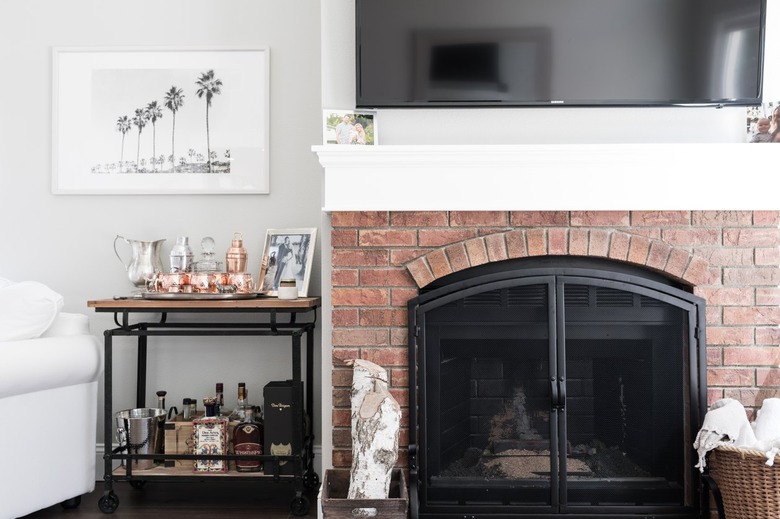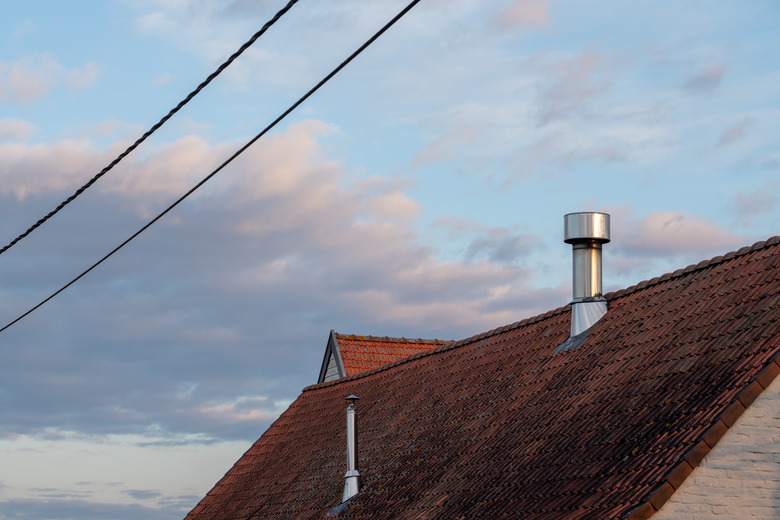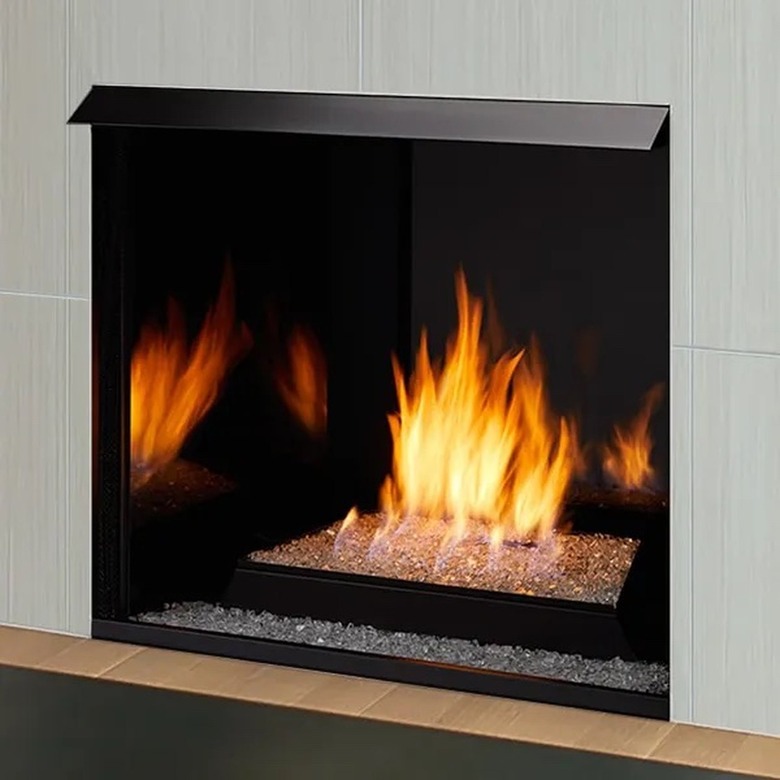Is A Gel Fuel Fireplace Right For You? Here's What To Know
We may receive a commission on purchases made from links.
The crackle of flames is oh so soothing, but adding a wood-burning fireplace isn't a realistic option for most homeowners who don't have one already. A gel fuel fireplace is a great alternative, allowing any homeowner to install a fireplace just about anywhere, even in spaces without a chimney, gas hookup, or electricity. Some gel fuel fireplace models are portable enough to be moved from one room to another or even outside. All you need to enjoy these unique fireplaces is a can of gel fuel. But gel fireplaces aren't ideal for everyone — as with all types of fireplaces, they have their pros and cons.
How Gel Fuel Fireplaces Work
How Gel Fuel Fireplaces Work
To light a fire in a gel fuel fireplace, you need isopropanol (isopropyl) alcohol gel canisters to fuel the flame. To start the fire, follow these instructions:
- Remove the
paper from the gel fuel can - Pry the lid from the canister
- Place the
container into the appropriate space in the fireplace, taking care not to spill
the highly flammable liquid. Some models will hold only one canister, while others can hold up to three for a little more light and heat. - Light the gel using a long-handled lighter or long matches so you aren't too close to the flames when they flare up. Most gel
fuel canisters are about 13 ounces and will burn for somewhere between
two and three hours.
To put out the fire before the can of gel fuel runs out and extinguishes itself:
- Carefully drop the lid back onto the can to smother the
flames - Wait for about an hour for the cans to fully cool before removing or relighting them
If you do need to relight the fire after extinguishing the flames, keep in mind that a fire from a previously used canister will typically be less robust than it was the first time around. Never add new fuel to an old container of fuel.
These fireplaces require virtually no maintenance. Simply toss the spent gel canisters and periodically wipe down the surface with a soft cloth to remove dust.
Gel Fireplace Types and Options
Gel Fireplace Types and Options
One thing people love about gel fuel fireplaces is that they are incredibly versatile. There are indoor models, outdoor models, and portable models that can be used both indoors and outdoors. You're certain to find a model that will match your style since they have so many different types available, including wall-mounted fireplace designs, midcentury modern fireplace styles, tables with built-in firescapes, tabletop fireplaces, and outdoor fire pits.
If you have an existing wood or gas fireplace, you can easily transform it into a gel fuel fireplace while maintaining the classic wood-burning appearance by adding a gel fuel fire log insert. A gel fireplace insert can give you the appearance of a traditional fireplace with real wood fire but with the signature clean-burning gel fuel instead. It's the best of both worlds.
Do Gel Fireplaces Need Venting?
Do Gel Fireplaces Need Venting?
A major selling point of gel fuel fireplaces is that they don't require a chimney, electricity, or a gas line. That means they can be installed in any well-ventilated area. These fireplaces are a great option for places where other fireplaces would be dangerous or impractical, or for renters who otherwise wouldn't be able to add a fireplace to their home.
Installation is simple too — most freestanding models only require you to set the fireplace in a location with even, solid flooring to minimize the risk of dangerous tip-overs. You can even store the fireplace somewhere else when it is not in use.
Gel fuel is an eco-friendly fireplace option that promotes air quality because it burns without releasing soot or other particulates. While some sources claim the gel fuel produces no carbon monoxide at all, this is not true, as anything that burns produces at least some level of carbon monoxide. That being said, this clean-burning fuel releases only a trace amount of carbon monoxide, 16 parts per million, which is dramatically lower than the 250 parts per million that is considered safe for exposure.
Of course, if you use the fire in a small room with no ventilation, that carbon monoxide can accumulate, and you may still run the risk of negative effects, such as headache, dizziness, weakness, nausea, or loss of consciousness. This is why it is important to always ensure there is sufficient ventilation in a room in order to maintain good air quality and to ensure there is enough oxygen available to keep the fire alive. You can improve ventilation by opening the windows (if there are any) or turning on a fan or two.
Does Gel Fuel Create a Good Ambiance?
Does Gel Fuel Create a Good Ambiance?
A major benefit of gel fireplaces is that they produce a slow-burning, real flame that burns in red, yellow, and orange colors just like the flames of a wood fireplace. While the gel fuel canisters all have an odorless isopropyl alcohol base, some gels contain additives made from a variety of organic materials to provide you with the classic crackling and spitting of burning wood (warning — these typically cost extra).
With these specific fuel canisters, gel fuel fireplaces can easily mimic the relaxing and romantic sights and sounds of a traditional wood-burning fireplace. Though they may not produce the same smell as a wood fire, this can be a good thing, as the classic "campfire smell" is a result of breathing in particulates and chemicals that aren't exactly good for your health, whereas the clean-burning gel fuel is better for your lungs and the environment as a whole.
Gel Fuel Fireplace Heat Output
Gel Fuel Fireplace Heat Output
Gel fuel fireplaces do provide some heat, but they are best used as a supplemental heat source since they do not get as warm as other fireplace options. If you're looking for a roaring fire to keep you warm in the dead of winter, a gel fuel fireplace isn't going to be the right option for you. On the other hand, if you live somewhere with temperate winters, like Southern California, the low heat output may be a selling point because you can enjoy a real fire in your living room without making the space swelteringly hot. Of course, if it's really warm outside, you may still prefer an electric fireplace, which offers you the option of enjoying the appearance of a realistic flame without activating the heating element to actually add warmth to your space.
In more specific terms, each can of gel fuel produces approximately 3,000 Btu (British thermal units) of heat over the course of two to three hours, so even a larger model that holds three cans can produce no more than 4,500 Btu in an hour. For context, a wood-burning fireplace can produce between 20,000 and 80,000 Btu per hour, a gas fireplace can produce between 8,000 and 60,000 Btu per hour, and electric fireplaces can produce between 4,600 and 9,000 Btu per hour. So, essentially, a gel fuel fireplace can produce around the same amount of heat as an electric fireplace.
It's also worth noting that although you can add more logs to increase the temperature in a wood-burning fireplace and you can turn up the heat on a gas or electric fireplace, there is no way to adjust the temperature on a gel-burning fireplace. Gel fuel canisters are either burning or not burning.
Gel Fuel Fireplace Costs
Gel Fuel Fireplace Costs
A major drawback to this type of fireplace is the cost. A gel fuel fireplace or a log fireplace insert will cost somewhere between $400 and $900, and you may need to shop around because these items are still somewhat rare being relatively new additions on the market. To put this in perspective, installing a new wood-burning fireplace can cost between $2,000 and $5,600, installing a gas fireplace will cost between $2,300 and $4,000, and a DIY plug-in electric fireplace will be around $100 to $700, though a hardwired electric model can cost as much as $2,200 including installation.
Of course, you can't operate a gel fuel fireplace without fuel canisters, which are simple enough to find and typically cost around $4 each, though those with additives to produce crackling sounds usually cost a little more, somewhere around $5 each. This comes out to around $1.33 to $1.66 per hour for a single-can fireplace and $4 to $5 per hour for a three-can fireplace.
While you may initially save some money buying a gel fuel fireplace over another type, the long-term cost of using gel canisters for heat will almost always be higher than other fuel options. Consider that many people get wood for their fireplace for free, but otherwise, a cord of wood can cost between $100 and $580 and provide around 700 hours of burn time, which comes out to an average of 49 cents per hour. Gas fireplaces cost even less to operate, with natural gas fireplaces costing an average of 40 cents per hour to run . Electric fireplaces are perhaps the least expensive option, costing only around 22 cents per hour.
If you only use your gel fuel fireplace on occasion to add a little coziness to your space, the increased price probably won't be dramatic enough to really matter. But if you plan to use the fireplace regularly, you're almost certainly better off choosing another type of fireplace, at least from a financial perspective. This is particularly true if you need to rely on your fireplace for times when the power goes out since the low heat output is unlikely to keep you warm, and the fact that you'll need to keep replacing canisters means your bank account balance may drop almost as fast as the temperature in your home.
Important Safety Considerations
Important Safety Considerations
Overall, gel fuel is safe to use, but as with any fireplace that has a real flame, gel fuel fireplaces can be dangerous if not used correctly. Avoid using outdoor fireplaces during high winds or in areas where they may be affected by rain or snow. Never leave the fire unattended and always keep a fire extinguisher nearby.







